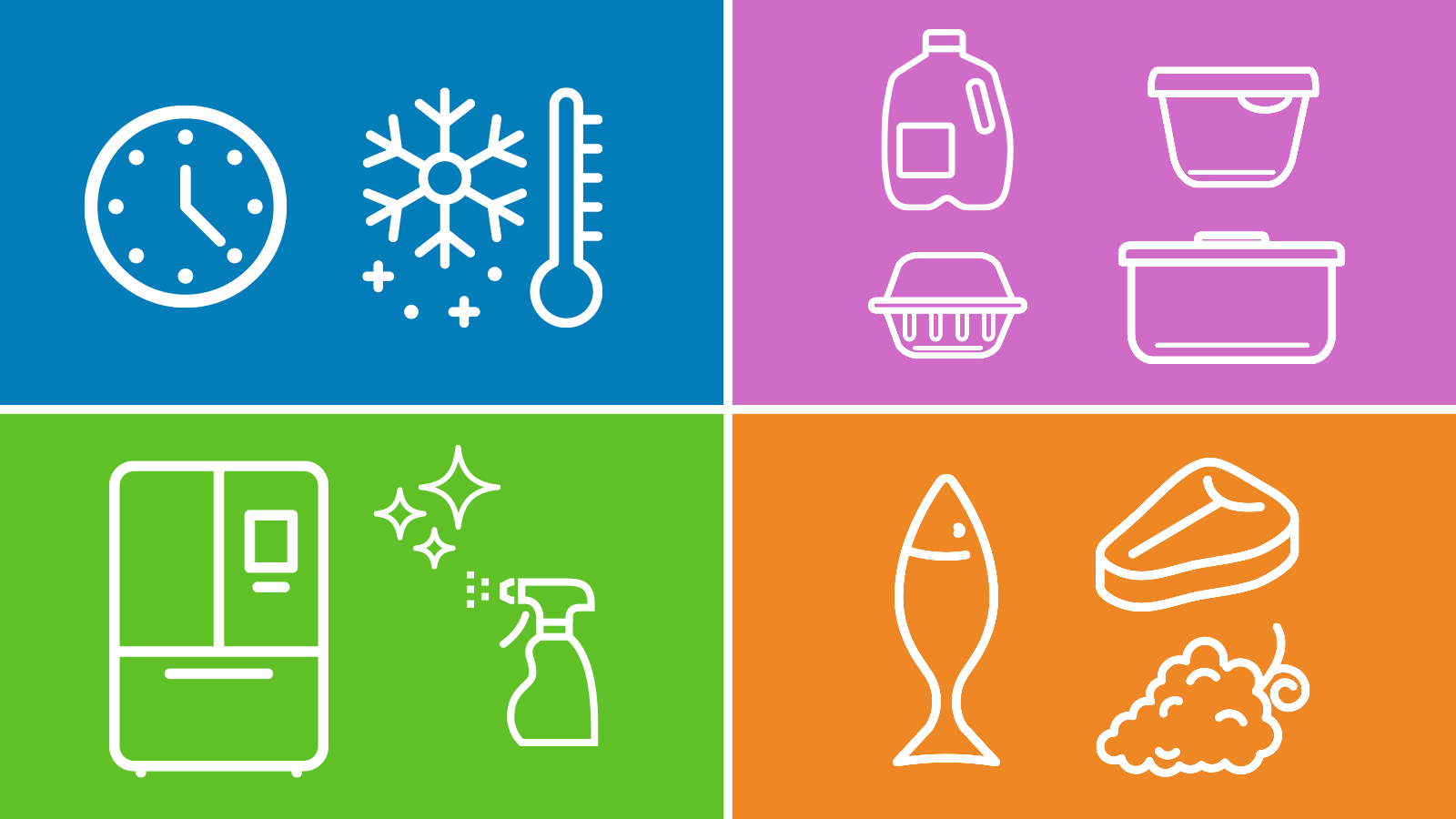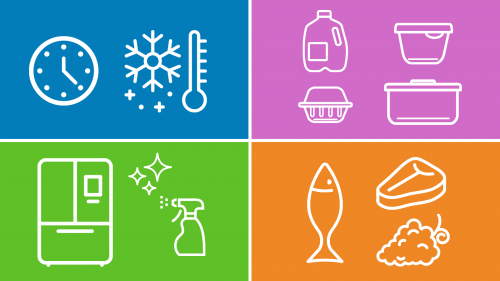
Image

Español
Whether putting food in the refrigerator, the freezer, or the cupboard, you have plenty of opportunities to prevent foodborne illnesses.
The goal is to keep yourself and others from being sickened by microorganisms such as Salmonella, E. coli O157:H7, and C. botulinum, which causes botulism. Keeping foods chilled at proper temperatures is one of the best ways to prevent or slow the growth of these bacteria.
These food storage tips can help you steer clear of foodborne illnesses.
Storage Basics
- Refrigerate or freeze perishables right away. Foods that require refrigeration should be put in the refrigerator as soon as you get them home. Stick to the “two-hour rule” for leaving items needing refrigeration out at room temperature. Never allow meat, poultry, seafood, eggs, or produce or other foods that require refrigeration to sit at room temperature for more than two hours—one hour if the air temperature is above 90° F. This also applies to items such as leftovers, “doggie bags,” and take-out foods. Also, when putting food away, don’t crowd the refrigerator or freezer so tightly that air can’t circulate.
- Keep your appliances at the proper temperatures. Keep the refrigerator temperature at or below 40° F (4° C). The freezer temperature should be 0° F (-18° C). Check temperatures periodically. Appliance thermometers are the best way of knowing these temperatures and are generally inexpensive.
- Check storage directions on labels. Many items other than meats, vegetables, and dairy products need to be kept cold. If you’ve neglected to properly refrigerate something, it’s usually best to throw it out.
- Use ready-to-eat foods as soon as possible. Refrigerated ready-to-eat foods such as luncheon meats should be used as soon as possible. The longer they’re stored in the refrigerator, the more chance Listeria, a bacterium that causes foodborne illness, can grow, especially if the refrigerator temperature is above 40° F (4° C).
- Be alert for spoiled food. Anything that looks or smells suspicious should be thrown out. Mold is a sign of spoilage. It can grow even under refrigeration. Mold is not a major health threat, but it can make food unappetizing. The safest practice is to discard food that is moldy.
- Be aware that food can make you very sick even when it doesn’t look, smell, or taste spoiled. That’s because foodborne illnesses are caused by pathogenic bacteria, which are different from the spoilage bacteria that make foods “go bad.” Many pathogenic organisms are present in raw or undercooked meat, poultry, seafood, milk, and eggs; unclean water; and on fruits and vegetables. Keeping these foods properly chilled will slow the growth of bacteria.
- Following the other recommended food handling practices will further reduce your risk of getting sick — clean your hands, surfaces and produce, separate raw foods from ready-to-eat foods, and cook to safe temperatures.
Refrigeration Tips
- Marinate food in the refrigerator. Bacteria can multiply rapidly in foods left to marinate at room temperature. Also, never reuse marinating liquid as a sauce unless you bring it to a rapid boil first.
- Clean the refrigerator regularly and wipe spills immediately. This helps reduce the growth of Listeria bacteria and prevents drips from thawing meat that can allow bacteria from one food to spread to another. Clean the fridge out frequently.
- Keep foods covered. Store refrigerated foods in covered containers or sealed storage bags, and check leftovers daily for spoilage. Store eggs in their carton in the refrigerator itself rather than on the door, where the temperature is warmer.
- Check expiration dates. A “use by” date means that the manufacturer recommends using the product by this date for the best flavor or quality. The date is not a food safety date. At some point after the use-by date, a product may change in taste, color, texture, or nutrient content, but, the product may be wholesome and safe long after that date. If you’re not sure or if the food looks questionable, throw it out.
- The exception to this is infant formula. Infant formula and some baby foods are unique in that they must be used by the use-by date that appears on the package.
Freezer Facts
- Food that is properly frozen and cooked is safe. Food that is properly handled and stored in the freezer at 0° F (-18° C) will remain safe. While freezing does not kill most bacteria, it does stop bacteria from growing. Though food will be safe indefinitely at 0° F, quality will decrease the longer the food is in the freezer. Tenderness, flavor, aroma, juiciness, and color can all be affected. Leftovers should be stored in tight containers. With commercially frozen foods, it’s important to follow the cooking instructions on the package to assure safety.
- Freezing does not reduce nutrients. There is little change in a food’s protein value during freezing.
- Freezer burn does not mean food is unsafe. Freezer burn is a food-quality issue, not a food safety issue. It appears as grayish-brown leathery spots on frozen food. It can occur when food is not securely wrapped in air-tight packaging, and causes dry spots in foods.
- Refrigerator/freezer thermometers should be monitored. Refrigerator/freezer thermometers may be purchased in the housewares section of department, appliance, culinary, and grocery stores. Place one in your refrigerator and one in your freezer, in the front in an easy-to-read location. Check the temperature regularly—at least once a week.
If You Lose Electricity
If you lose electricity, keep refrigerator and freezer doors closed as much as possible. Your refrigerator will keep food cold for about four hours if it’s unopened. A full freezer will keep an adequate temperature for about 48 hours if the door remains closed.
Once Power is Restored . . .
You’ll need to determine the safety of your food. Here’s how:
- If an appliance thermometer was kept in the freezer, check the temperature when the power comes back on. If the freezer thermometer reads 40°F or below, the food is safe and may be refrozen.
- If a thermometer has not been kept in the freezer, check each package of food to determine its safety. You can’t rely on appearance or odor. If the food still contains ice crystals or is 40 °F or below, it is safe to refreeze or cook.
- Refrigerated food should be safe as long as the power was not out for more than four hours and the refrigerator door was kept shut. Discard any perishable food (such as meat, poultry, fish, eggs or leftovers) that has been above 40°F for two hours or more.
Tips for Non-Refrigerated Items
- Check canned goods for damage. Can damage is shown by swelling, leakage, punctures, holes, fractures, extensive deep rusting, or crushing or denting severe enough to prevent normal stacking or opening with a manual, wheel-type can opener. Stickiness on the outside of cans may indicate a leak. Newly purchased cans that appear to be leaking should be returned to the store for a refund or exchange. Otherwise, throw the cans away.
- Keep food away from poisons. Don’t store non-perishable foods near household cleaning products and chemicals.
Source: FDA
This webpage is made available by Online Press Release, Micro News






